
|
Sale 31
Pre-Long Beach Coin Auction
| Lot |
Photo |
Description |
Realized |
Lot 2219 |
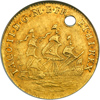 |
Great Britain. Gold Touch Piece, ND. James II. BMI-19. Woolf obv 2 rev 2. Holed. St Michael killing a dragon on the obverse and a ship in full sail on the reverse. Used in 'touching' ceremonies, where those who suffered from scrofula were brought to be cured. This is a fine example of a gold coin which was symbolically holed. Normally seen in somewhat lower grades. NGC graded AU-55.
Estimated Value $700 - 900.
The Cheshire Collection.
View details and enlarged photos
| Realized
$1,610 |
Lot 2220 |
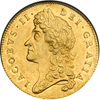 |
Great Britain. 5 Guineas, 1688. S.3397; Fr-292. James II, 1685-1688. First laureate bust left. Reverse: Cross of four crowned shields with sceptre between each shield. All James II 5 Guineas are rare in high grade. They were the largest gold coins of the era and produced in relatively small quantities - nevertheless they circulated widely during James's short three year reign and beyond. Most available specimens are worn, damaged or mounted. This virtually uncirculated specimen is indeed special. Conservatively graded at AU-58. NGC graded AU-58.
Estimated Value $12,500 - 15,000.
The Cheshire Collection.
View details and enlarged photos
| Realized
$16,100 |
Lot 2221 |
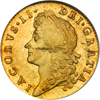 |
Great Britain. Half Guinea, 1688. S.3404; Fr-297; KM-458.1. James II. Only one portrait style issued for this monarchs short reign. Softly struck in the center on both sides. Considerable original mint luster. Very Rare in grade. NGC graded MS-63.
Estimated Value $3,000 - 4,000.
View details and enlarged photos
| Unsold |
Lot 2222 |
 |
Great Britain. Silver Crown, 1687. James II. S-3407. Second draped bust. Edge not viewable in the slab, probably "TERTIO." Very scarce type, usually not found much better than VF. This reign was very short, producing some of the rarest milled coins, in various denominations, of the century. This is the one date crown that does, occasionally, appear in Uncirculated condition. Excellent eye appeal thanks to strong luster and bright amber-gold iridescent toning, of which the coin simply sparkles, but given the 62 number because of a long, ancient scratch in the field to the left of the portrait, right along the bottom of the legend and not all that noticeable. The flan, however, is exceptionally nice (without the usual black flaws) and overall the strike is better than usual albeit there is a touch of softness at the top of the king's hair and on the opposite side at the top of one shield. However, the centers are well defined and the portrait is very pleasing! NGC graded MS-62.
Estimated Value $3,500 - 4,000.
The Cheshire Collection.
View details and enlarged photos
| Realized
$6,325 |
Lot 2223 |
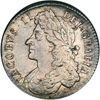 |
Great Britain. Halfcrown, 1687. James II. S-3408. 1st draped bust. Edge not visible in the slab. High-grade silver of this reign figures among the most difficult to acquire, in the entire British milled series. It is easier, in fact, to find a nice Guinea than a nice halfcrown of this king. Here is an exceptionally attractive example. Very well struck with some luster, admittedly disturbed, but overall the fields are unusually nice for this issue. The digits and letters are all clear, which is also above the norm. Additionally, there are no distracting black streaks or carbon or so-called hay marks on either side, making for a nicer eye-appeal than is typical. Rare and desirable, an important type coin! NGC graded MS-61.
Estimated Value $2,750 - 3,250.
The Cheshire Collection.
View details and enlarged photos
| Realized
$3,105 |
Lot 2224 |
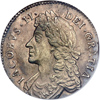 |
Great Britain. Silver Shilling, 1687/6. James II. S-3410. Shillings of this reign are among the rarest of all English silver coins, of all periods. Few are known as nice as EF grade. Most pieces circulated hard, for years, and today are VF or less. Uncirculated coins exist but are very, very rare. This coin is up toward the top of the collectible shillings of James II, showing a touch of wear and brightening. The color is light silvery gray. At arm's length, it's obvious that much luster remains intact. Strike is quite sharp, as usually seen. The overdate is clear but a common feature in this short-lived series, where dies were obviously reused. A few small pecks and marks, but overall an excellent example of the coinage. NGC graded AU-58.
Estimated Value $2,250 - 2,750.
The Cheshire Collection.
View details and enlarged photos
| Realized
$2,013 |
Lot 2225 |
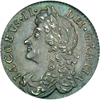 |
Great Britain. Sixpence, 1686. S.3412; ESC-1525; KM-456.1. James II. This is an exceptional, prooflike coin with a deep old tone and free from edge or rim defects or surface problems which plague this series. As nice a James II sixpence as it is impossible to find. Rare this nice. NGC graded MS-64.
Estimated Value $1,600 - 1,900.
The Cheshire Collection.
View details and enlarged photos
| Realized
$1,380 |
Lot 2226 |
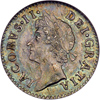 |
Great Britain. Maundy Set, 1687. S.3418; ESC-2382. James II. A beautifully toned and rare set this nice. 4 Pence NGC MS-64; 3 Pence NGC MS-64; 2 Pence NGC MS-64; Penny NGC MS-66. Lot of 4 coins.
Estimated Value $900 - 1,100.
The Cheshire Collection.
View details and enlarged photos
| Realized
$1,080 |
Lot 2227 |
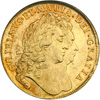 |
Great Britain. 5 Guineas, 1692. S.3422; Fr-299. William and Mary, 1688-1694. 7 strings to harp, 11 pellets by lion. Mary Stuart was the daughter of James II and married William III as part of Charles II's foreign policy. William and Mary reigned jointly from 1688 until her death from smallpox at the untimely age of 32 in 1694. The Five Guineas was the largest of their gold coins and featured the conjoined busts of the two monarchs, as this was the only time in British history that joint monarchs' portraits appeared on currency. All William and Mary coins are rare in high grade and this superb piece is no exception, with a pleasant red tone. NGC graded MS-61.
Estimated Value $15,000 - 18,000.
The Cheshire Collection.
View details and enlarged photos
| Realized
$14,950 |
Lot 2228 |
 |
Great Britain. 2 Guineas, 1693. William & Mary, jugate busts. S-3424; Fr-301. Gold was not plentiful during the few years of this joint monarchy, and most of the types and dates are very rare, especially when they are of such superb condition as the present specimen. This splendid coin shows the two portraits side by side, each in intimate detail, each a portrayal of the monarchy as it could only have been "drawn" in the 1690s. Its artistic style is precisely of its time. The royal shield on the reverse side is equally impressive, a model of efficiency which includes essentially every regal symbol relating to this king and this queen. Unique to it is the deeply curved seashell ornament that appears on each side of the shield, so reminiscent of the "heavenly" door out of which Venus steps in the masterpiece of Botticelli, the Italian Renaissance painter. Whether this was in fact an influence on the engraver of this coin could make for a fine study. The coin itself does indeed stand for the flowering of a new monarchy in England, for the king was the former Prince William of Orange, a diminutive Dutchman who both "invaded" Britain and was welcomed by its Parliament, then searching for a replacement for King James II, who had "turned Catholic" while on the throne. The fear was that religious strife would be refired, something Parliament and the citizenry at large wished to avoid at all costs. William was a Protestant, and his tie to the British Royal Family was undeniable: he was the nephew of Charles II, and married the daughter of James, Duke of York, later James II. She was raised a Protestant and clung to that faith after her parents converted to Catholicism. Her marriage was actually proposed by King Charles II himself, a marriage of convenience when she was just 15. The couple came to the throne of England in what has been called the Bloodless Revolution, solving the religious problem for the land. They had an affectionate marriage but no children. Mary II, as she was properly known in life, died of smallpox in December 1694 at age 32. Her husband went on to rule as William III for another eight years but left no heir. Theirs was an age of elegance, when modern politics was born. This specimen, virtually as struck and a glorious emblem of its time, is especially fine in quality with beautiful golden red toning. NGC graded MS-63.
Estimated Value $14,000 - 17,500.
The Cheshire Collection.
View details and enlarged photos
| Realized
$16,100 |
Lot 2229 |
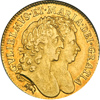 |
Great Britain. Guinea, 1689. S.3427; Fr-305; KM-474.2. William and Mary. G over I in Regina. Elephant and castle below busts. This variety not in the Terner collection. Minor reverse field scrape. Lustrous with lovely light toning. Extremely rare. NGC graded AU-58.
Estimated Value $5,000 - 7,000.
The Cheshire Collection.
View details and enlarged photos
| Realized
$6,613 |
Lot 2230 |
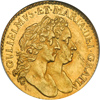 |
Great Britain. Gold Half Guinea, 1689. William & Mary, jugate busts. S-3429. First busts. Only year of this style, for the portraits were re-worked a bit for the next issue of 1690. Very rare as a type. Finding good-quality coins of this monarchy is particularly difficult; nice half-guineas are rarer than the admittedly rare guineas, twos and fivers, even though those denominations are more highly priced. Not comparable to either of the Terner specimens, which enjoyed a special sparkle, this is nonetheless a most pleasing coin, having old toning, a nice single strike on the portraits, and only a little weakness in strike in the center of the reverse shield. What is particularly noteworthy and important for collectors is this coin's lack of the metal-flaws, poor edges and surface striations so commonly found on even the nicest gold of this reign. In other words, this is a premium coin with a light glow to its beautiful yellow gold. Catalogues for £4,000 (about $8,000) in EF in the 2005 Spink price guide. We feel that is about the value of this piece. NGC graded MS-60.
Estimated Value $6,500 - 8,000.
The Cheshire Collection.
View details and enlarged photos
| Realized
$5,750 |
Lot 2231 |
 |
Great Britain. Silver Crown, 1692/2. Last "2" of date over inverted "2." William & Mary, jugate busts. S-3433. Edge not readable in the slab but probably "QVARTO" as NGC has attributed it as ESC-84. This dual monarchy produced the rarest coins of their century, with crowns struck in only two years, 1691 and 1692. This curious "overdate" is rated R3, extremely rare, by ESC's Alan Rayner. The cataloguer has seen perhaps two truly Uncirculated examples of this crown, over a period of 25 years. Any grade close to MS is also very, very rare. Here we have a wonderfully preserved example, one of the finest to be found in terms of eye appeal. Small abrasions only; nice rims with one small depression near "HI" on reverse (looks like the form of the planchet, not a bump). The strike is even and excellent, all major details well defined, only a few letters of the legends showing any softness of impression. Luster remains evident beneath bright, medium blue-gray toning. All in all, this coin enjoys exceptional detail, and is unusually attractive. A most impressive representation of this rare coinage type! NGC graded AU-53.
This wonderful crown, and the others of this era, are mementos of a fascinating period in British history, when the Churchill family came to prominence and the unwritten constitution faced a series of challenges involving succession. In the mid-1680s, King James II revealed his allegiance to Catholicism and the ancient "battle" over religion in England resumed, to the general distress. Several years of chaos ensued, ending in the king's exile to France and, in effect, an empty throne. It is known to history as the Bloodless Revolution. Parliament searched for a blood heir to majesty and found Prince William of Orange, a tiny principality near Avignon. He was nephew of both Charles II and James II. He had visited England since 1670 and was keenly aware of his English lineage. In 1677 he had married Mary, daughter of James II, who in fact had objected to the marriage as it was a Protestant alliance but accepted it as politically advantageous to him at the time. When England found itself with its throne empty, the Dutch prince "invaded" English shores but was more welcomed than challenged, for the pair were discovered to be ideal, healing the nation of religious difficulties by the return of Protestantism. Mary was back home, though married to a man whom the British nicknamed "the little Dutchman" after his short stature and taciturn disposition. They ruled largely in name, for the age of politics had arrived in England and decisions were made by Parliament and whispers in privileged ears. William came to miss his former home but the British, French and Dutch were at war and so visits became impossible. Mary died of smallpox in 1694, which took a further toll on the king's poor health. It became apparent that the Princess Anne, pushed aside during the Bloodless Revolution as niece of Chares II, would become the next monarch, and this became reality when William's horse stumbled over a mole-hill while the king was riding at Hampton Court in February 1702. He broke his collar-bone and expired within two weeks. Anne claimed the throne that should have been hers in 1689 but she was not adept at the new politics and relied upon the advice of Sarah and John Churchill to act as figurehead of the nation. Her health was also poor and at first she was not popular, but she vowed to the people to preserve the Church of England and slowly gained acceptance until the great victory was won at the Battle of Blenheim in 1704, under the Duke of Marlborough, John Churchill. The Churchill family was rewarded with a great estate, but court animosities ended the queen's friendship with them. Peace came with France at long last, political union occurred with Scotland in 1707, and the queen's marriage to Prince George of Denmark was generally happy, but poor Queen Anne suffered illnesses caused by extreme overweight, lost her husband in 1708, and experienced the worst fate of any parent, the death of each of her numerous children. Her reign is remembered as glorious and golden, an age of plenty and victory. With her died an era, the Stuart line, and the remnant power of monarchy.
Estimated Value $4,500 - 5,500.
The Cheshire Collection.
View details and enlarged photos
| Realized
$5,290 |
Lot 2232 |
 |
Great Britain. Halfcrown, 1689. William & Mary, jugate First busts. Second Shield. S-3435. ESC-508. Frosted caul with pearls. This short reign (1688-94) produced some of today's rarest coins, in high grade, the shillings and sixpence in particular (in silver) being ultra-rare in Mint State. Halfcrowns of the first two styles do occur, and evidently a small number were saved at or around the time of their issue by admirers (although, as we have noted elsewhere in this catalogue, William's admirers were few and far between in his day). The halfcrowns are actually common in Fine and VF, but above that they become difficult. In the grade represented by this delightful specimen, they are very rare indeed. Here then is a significant collecting opportunity which should not be missed, one of the finest known halfcrowns of this short reign. NGC graded MS-63.
Estimated Value $2,500 - 3,000.
The Cheshire Collection.
View details and enlarged photos
| Realized
$2,645 |
Lot 2233 |
 |
Great Britain. Silver Shilling, 1693. William & Mary. S-3437. 9/0 variety in date. Conjoined busts facing right. At the top of the rarity list, among all milled silver coins, ranking perhaps #1 and #2 of all types, are the crowns and shillings of this dual monarchy. The cataloguer has seen one legitimate Uncirculated crown in 25 years, but not a single shilling. The finest seem to have at least a touch of wear, which is the case here. Just a hint of actual wear, but "hard" luster, toned an enchanting mauve and bluish gray. Strike is excellent, but the dies clashed, showing impressed elements of each side's design on the other side. There are no marks or any other "distractions," and if this coin were Uncirculated it would have to be called 63 or 64 for its qualities. Indeed, a lot of late 17th-century luster remains beneath the toning!
Few cataloguers have commented on the intricate reverse design of this classic of English numismatics. In the fields between the quadrants of the shield are inter-linked "W" and "M" initials, a feature unique to this monarchy; the date is placed concentrically around the center device, each digit one that could only have been formed at this time in history; and finally the lion standing in miniature on its two hind feet, at the reverse center, is within a disconnected cartouche that is meant to stand for a shield, and on this shield are tiny squares, themselves standing for the shields of the royal household. Thus we have insignia, shields on a shield within the quadrants of a larger shield, regal titles in Latin, a dual monarchy, and great rarity all on one "simple" shilling: as good as it gets, really, in an English coin! NGC graded AU-55.
Estimated Value $2,350 - 2,850.
The Cheshire Collection.
View details and enlarged photos
| Realized
$2,070 |
Lot 2234 |
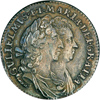 |
Great Britain. Sixpence, 1694. S.3438; ESC-1531; KM-481. William and Mary. Rare two year type. Well struck with a trace of luster and lovely old gray toning. NGC graded AU-55.
Estimated Value $1,250 - 1,750.
The Cheshire Collection.
View details and enlarged photos
| Realized
$978 |
Lot 2235 |
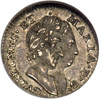 |
Great Britain. Silver Penny, 1694. William & Mary, bust side by side. S-3445. Rare variety with "HI" in place of "HIB" in reverse legend. Very attractive light gray surfaces, well struck for the type. An extremely rare grade for this piece, which is usually missing from Maundy sets as many evidently have been lost over the centuries. We feel our estimate is conservative, as many collectors need this tiny type coin. NGC graded MS-62.
Estimated Value $275 - 350.
The Cheshire Collection.
View details and enlarged photos
| Realized
$311 |
Lot 2236 |
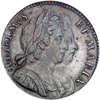 |
Great Britain. Halfpenny, 1694. S.3452. William and Mary. Conjoined busts right. This is an unusually sharp example of a coin which was notoriously badly made and weakly struck. Only the slightest trace of the usual spotting in the metal. NGC graded MS-61 Brown.
Estimated Value $1,750 - 2,000.
The Cheshire Collection.
View details and enlarged photos
| Unsold |
Lot 2237 |
 |
Great Britain. Proof silver Farthing, 1694. William & Mary. P-623. Type as S-3453, normal stops and legends, but struck in silver, not copper. Curiously misshappen flan, which is not at all uncommon on Proofs of this era. In fact, lightly cleaned but nicely retoned, light gray. What's most appealing about this rarity is that it has seen no real abuse, has no marks or scratches or flan flaws, the things which normally plague coins of this era. Nice copper examples are virtually impossible to find, so this handsome silver strike was chosen for the Cheshire Collection to represent the type. Despite modest value, this coin is one of the rarest pieces in this entire collection, in terms of the sheer difficulty of finding an example, any decent example, to illustrate William & Mary's smallest denomination coin (Maundies aside). Farthing enthusiasts should crowd in on this one! NGC graded Proof 61.
Estimated Value $1,250 - 1,500.
The Cheshire Collection.
View details and enlarged photos
| Realized
$1,553 |
Lot 2238 |
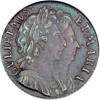 |
Great Britain. Farthing, 1694. S.3453. William and Mary. Bold strike. NGC graded MS-61 Brown.
Estimated Value $1,100 - 1,300.
The Cheshire Collection.
View details and enlarged photos
| Realized
$1,035 |
Lot 2239 |
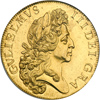 |
Great Britain. 'Fine Work' 5 Guineas, 1701. S.3456; Fr-310. William III. Exceptionally sharp in strike with fine hair detail not seen in other high-grade examples. William III ruled alone after the death of his wife (Mary II) until his own demise on 8th March 1702 following a serious fall from a horse. The 'Fine Work' gold coins of William III are among the most spectacular of the period. Seldom attributed to any particular purpose, but probably the work of John Croker, who seems to have been responsible for the experimental portraits all done within a few years of this, probably including those used on the piedfort Proof halfcrowns, the "flaming hair" shillings (S-3515), and the gold pieces of 1701 featuring the king adorned in what must be a fancy periwig hairpiece. The 5 Guinea coin, of course, shows this wonderfully detailed, deeply cut engraving off to best advantage. Seems better than the numerical grade given as the surfaces are glassy or prooflike and gleaming with luster, and it is exceptionally well struck even for this style. The king's locks are engraved as a chisel might cut into the finest marble, of exceptional fineness, and the reverse design is equally bold. The gold itself is lovely, without flaws of any real note. Tied with the best of these, as several exist in Mint State. One of the most beautiful coins in the entire Cheshire Collection. Spink 2005 catalogue prices the coin at £10,000 (currently $20,000) in only XF condition (not priced in higher grades). Coins of this quality are fast disappearing. NGC graded MS-62.
Estimated Value $20,000 - 25,000.
The Cheshire Collection.
View details and enlarged photos
| Realized
$21,275 |
Lot 2240 |
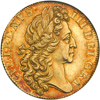 |
Great Britain. Two Guineas, 1701, "Fine Work." William III. S-3457; Fr-310. Most "twos" will probably never catalogue at the same level as the "fivers," but as all advanced gold collectors know only too well, the Two guinea coins are rarer as a class than the Fives. In the case of these Fine Work issues, the fact is that the two largest denominations are probably of about equal rarity, and it's the guinea that's the real challenge in the highest grade. Nonetheless, we are talking true rarity here, as well as extra-nice condition. This specimen is graced by a delightful, old red tone, indicative that it's not been touched or fiddled with ever. Although completely different in eye-appeal, it's the perfect companion to the Fiver of this style, and like that coin seldom seen in such a gorgeous state of preservation. The owner comments that "so fine was the workmanship on this particular coin that it would be difficult to determine if this was originally a presentation piece or item of superior finish." Certainly worthy of a fine collection of British gold coins. NGC graded MS-63.
Estimated Value $10,000 - 12,500.
The Cheshire Collection.
View details and enlarged photos
| Realized
$13,800 |
Lot 2241 |
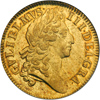 |
Great Britain. Guinea, 1700. S.3460; Fr-309; KM-498.1. William III. Second laureate Bust. Human-shaped harp on shield. Natural edge flaw at 3 o'clock. Faint adjustment marks on obverse. Lustrous. Very Rare. NGC graded AU-58.
Estimated Value $2,500 - 3,500.
View details and enlarged photos
| Realized
$4,888 |
Lot 2242 |
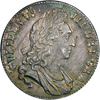 |
Great Britain. Silver Crown, 1695. William III. S-3470. First bust, and first year of issue for this monarch as sole ruler. Edge not viewable in the slab but designated by NGC as "OCTAVO." Cartwheel luster remains beneath light silvery gray toning, with bright hues of golden green iridescence. The surfaces are remarkably clean, free from marks. On the reverse, two small carbon deposits, thin and possibly removable, appear near the center. The details are all sharply struck, with an amazing amount of tiny detail visible in the shield. An excellent coin! Ex Van Roekel, who for 30 years or more sought the best example of each crown variety; this "OCTAVO" edge is extremely rare in high grade, and this specimen is likely the finest known. NGC graded MS-64.
Estimated Value $2,500 - 3,000.
The Cheshire Collection.
View details and enlarged photos
| Realized
$3,105 |
Lot 2243 |
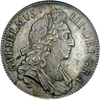 |
Great Britain. Silver Crown, 1695. William III. S-3470. First bust. Edge not viewable in the slab but designated by NGC as "SEPTIMO." First year of issue for this king. A delightful specimen! Medium golden gray toning, but bright, evenly distributed on both sides, providing premium eye-appeal. Well struck, the king's hair well defined and the reverse shield exceptionally sharp in all details. Nice high rims and wide denticles. Evidence of die-rust in the fields, and a touch of black alloying flecks in the metal. One of the most pleasing to be found! Very rare in this exalted grade. NGC graded MS-63.
Estimated Value $2,200 - 2,400.
The Cheshire Collection.
View details and enlarged photos
| Realized
$2,300 |
Lot 2244 |
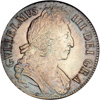 |
Great Britain. Silver Crown, 1696. William III. S-3470. First bust. Edge not viewable in the slab but designated by NGC as "OCTAVO." Second year of issue for this king as sole ruler. An exceptionally choice, fully Uncirculated or Mint State crown which is among the finest seen by this cataloguer. The luster is classic of its era, slightly pebbly but nonetheless producing a cartwheel effect. The texture of the surfaces is also endemic of the late 1690s' silver-blank preparation by the Royal Mint. Ancient equipment originally designed for rolling and coining thin, light-weight coins was still being used, at the mint facilities which stood in the same place inside the outer walls of the Tower of London since the 12th century. Considering all this, it was something of a magical feat to be able to produce a coin of this size and weight, so impressively. This wonderful specimen is blessed by gorgeous silvery gold iridescence, a sharp strike throughout, and extraordinarily mark-free surfaces and rims. Two large lumps of die-rust may be seen in two of the open quarters of the reverse shield; these do not detract from either the appeal or the value of this crown. Here indeed is a numismatic classic, and a gem of a coin! NGC graded MS-64.
Estimated Value $2,800 - 3,300.
The Cheshire Collection.
View details and enlarged photos
| Realized
$3,450 |
Lot 2245 |
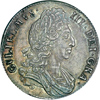 |
Great Britain. Silver Crown, 1697. William III. S-3473. Third draped bust. 2nd harp. Edge not viewable in the slab, but designated as ESC-96 (i.e., "NONO" regnal year) by NGC. This coin is so rare that it is not illustrated by the Spink guidebook. Nor has the cataloguer, in over 25 years of writing about the best in British coinage, ever seen an example! It catalogues for 13,500 Pounds in the 2005 Spink book, in EF grade, one of the highest estimates of value for any crown, of any period. Here indeed is a landmark offering, a beautiful example, virtually Mint State! The slightest rub may be seen on the highpoints, but there remains strong 17th-century luster beneath unusually pretty, dark gray toning with hues of iridescence. The color is well set. The surfaces are hard to believe, showing a sheen not seen in many coins of the 1690s, of any denomination or even of any country. A few small pecks can be found here and there. A long die-break that looks like an adjustment, but is not, starts at the "V" in the king's name, disappears in the field, and resumes through the lower curls above the king's shoulder. The portrait is well struck, excellently balanced. The rims are clean and lightly denticled. The reverse is slightly die-rotated. Again, on the reverse side, the same sheen of luster remains under the same beautiful, dark gray toning. A few dots of minute die-rust appear in quadrants two and four, between the shield's arms. The strike on the shield, right to the center, is almost medallic in quality, it is so sharp. The letters of the legends show classic bifurcation at their bases. The date itself, so important on this coin, is clear and unmistakable, although the "97" digits are finely engraved, thin but very distinct. One of the most important coins in the Cheshire Collection, certain to elicit bids that leave the price guide in the dust, for the next nicest piece is in the VF grade range, meaning that catalogue value for "EF" is nothing but an extrapolated guess. Finest known. NGC graded AU-58.
Estimated Value $28,000 - 32,000.
The Cheshire Collection.
View details and enlarged photos
| Realized
$25,200 |
Lot 2246 |
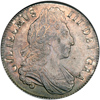 |
Great Britain. Silver Crown, 1700. William III. S-3474. Third bust. Edge not viewable in the slab but designated by NGC as ESC-97, which would be "DVODECIMO" edge, the standard regnal year for this date. Gleaming luster, bright silvery toning with golden hues, sharply struck on both sides with an especially fine portrait and a deeply detailed shield. Excellent rims and wide denticles. Most crowns of this date (even the nicer ones) are plagued by striations or file-lines, as well as imperfect flans. This wonderful coin has none of those problems. Exceptional in every respect! NGC graded MS-63.
Estimated Value $3,000 - 3,500.
The Cheshire Collection.
View details and enlarged photos
| Realized
$3,240 |
Lot 2247 |
 |
Great Britain. Halfcrown, 1698. William III. S-3494. 1st draped bust. Edge not visible in the slab. At first glance this coin seems dull, but take it out of artificial light and you see the mint gleam beneath toning which is typical of the nicer silver of this era: light silvery gray with golden highlights. Turn the coin, and the cartwheel luster is evident, something not seen in almost all examples of this type. As well, the strike is quite sharp and balanced, the devices of the shield nicely detailed. Lacking are the usual deficits seen on this date, including off-center strike, grease on the dies making for lacking details, and heavy marks. Overall, a most pleasing coin worthy of the grade given on the slab. NGC graded MS-63.
Estimated Value $1,200 - 1,500.
The Cheshire Collection.
View details and enlarged photos
| Realized
$1,380 |
Lot 2248 |
 |
Great Britain. Halfcrown, 1698. S.3494; ESC-554. William III. First bust. Bit of a soft strike, multi color tone. NGC graded MS-63.
Estimated Value $700 - 900.
View details and enlarged photos
| Realized
$978 |
Lot 2249 |
 |
Great Britain. Halfcrown, 1698. S.3494; ESC-554. William III. Light haymarking on both sides. Lustrous with light golden toning. NGC graded MS-62.
Estimated Value $900 - 1,100.
View details and enlarged photos
| Unsold |
Lot 2250 |
 |
Great Britain. Halfcrown, 1700. S.3494; ESC-561. William III. Although a relatively common coin in low grade this is an exceptional specimen. Well struck with a lovely original green and blue toning and considerable original mint luster. NGC graded MS-62.
Estimated Value $1,250 - 1,500.
The Cheshire Collection.
View details and enlarged photos
| Realized
$1,380 |
Lot 2251 |
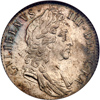 |
Great Britain. Shilling, 1697. S.3507; ESC-1102. William III. Third bust. Original fresh mint luster, silvery gray obverse, reverse toned more deeply but struck up better than is usually encountered. NGC graded MS-64.
Estimated Value $850 - 1,000.
The Cheshire Collection.
View details and enlarged photos
| Realized
$978 |
Lot 2252 |
 |
Great Britain. Shilling, 1700. S.3516; ESC-1121A. William III. Fifth bust. Small round O's in date. Attractively toned, an even medium gray; well struck on both sides. NGC graded MS-63.
Estimated Value $550 - 650.
The Cheshire Collection.
View details and enlarged photos
| Realized
$633 |
Lot 2253 |
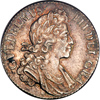 |
Great Britain. Shilling, 1700. S.3516; ESC-1121. William III. Fifth bust. Tall O's in date, with stops. Lustrous with light toning, a handsome mixture of gray and gold. NGC graded MS-62.
Estimated Value $500 - 600.
The Cheshire Collection.
View details and enlarged photos
| Realized
$403 |
Lot 2254 |
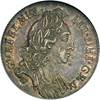 |
Great Britain. Sixpence, 1696. S.3520; ESC-1533; KM-484.1. William III. First bust. Bold strike with lovely gray toning. NGC graded MS-63.
Estimated Value $300 - 400.
The Cheshire Collection.
View details and enlarged photos
| Realized
$242 |
Lot 2255 |
 |
Great Britain. Sixpence, 1696 Y. S.3526; ESC-1539; KM-484.7. William III. First bust. York mint. Lustrous and lightly toned. NGC graded MS-62.
Estimated Value $500 - 600.
The Cheshire Collection.
View details and enlarged photos
| Realized
$575 |
Lot 2256 |
 |
Great Britain. 6 Pence, 1697. S.3538; ESC-1566. William III. Third bust. Brilliant and fully lustrous example. NGC graded MS-65.
Estimated Value $400 - 500.
View details and enlarged photos
| Unsold |
Lot 2257 |
 |
Great Britain. 6 Pence, 1697. S-3538; ESC-1566; KM-496.1. William III. Haymarking. Lustrous and toned. NGC graded MS-63.
Estimated Value $300 - 350.
View details and enlarged photos
| Unsold |
Lot 2258 |
 |
Great Britain. Sixpence, 1700. S.3538 KM-496.1. William III. Third bust.Toned. NGC graded MS-65.
Estimated Value $400 - 500.
The Cheshire Collection.
View details and enlarged photos
| Realized
$456 |
Lot 2259 |
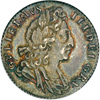 |
Great Britain. Sixpence, 1701. S.3538; ESC-1581; KM-496.1. William III. Third bust. Fully lustrous with lovely old toning. Last year of reign, rare this nice. NGC graded MS-63.
Estimated Value $750 - 850.
The Cheshire Collection.
View details and enlarged photos
| Unsold |
Lot 2260 |
 |
Great Britain. Silver Sixpence, 1697. William III. S-3542. Third bust. One of the most common of the earlier milled coinages, struck in large numbers (at a number of mints around the country) during what was called the "Great Recoinage." The Crown relented for once, allowing the populace to turn in any old coins, no matter how ragged or worn or bent or partial, at full face value. In return they were given shiny new examples of this coin. Hence they were saved in small numbers, here and there, not usually by intent. The purpose of the act was to clear away the despicable old coins, but it also caused many previous issues to become rarer. Witness the rarity of a coin such as the 1677 sixpence we commented on elsewhere. Mostly, it was centuries of hammered silver that went into the melting pot in 1697 and produced these handsome coins. Quite a few have been certified already, and more will be, but the grading companies do not seem to understand these particular issues too well. Many coins seen in MS slabs are not Mint State, but shiny AU coins. The trouble is caused by the dies, which often were not fully filled out when coins were struck. Also, grease on the dies caused many struck coins to be less than fully detailed, with high points that are "fuzzy." This is easily mistaken for wear and, conversely, worn coins are easily mistaken for soft-die coins. Thus the slabbing populations are going to be less than accurate, and in reality nice, truly Choice examples, like this specimen, are scarcer than many people will deduce. This is indeed a sparkling and very nice Mint State coin. Die-clashing shows, the toning is a silvery gray; the coin has flash and originality, and really is Uncirculated. NGC graded MS-64.
Estimated Value $350 - 450.
The Cheshire Collection.
View details and enlarged photos
| Realized
$288 |
Lot 2261 |
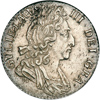 |
Great Britain. Sixpence, 1697. S.3542. William III. Third bust. Small crowns. G over D in GRA. Extremely rare. Only a handful are know to exist with this variety, and this is in mint state. Probably the finest known. NGC graded MS-63.
Estimated Value $1,250 - 1,750.
The Cheshire Collection.
View details and enlarged photos
| Realized
$1,725 |
Lot 2262 |
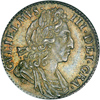 |
Great Britain. Sixpence, 1698. S.3546; ESC-1575; 496.9. William III. Third bust. Plumes in reverse angles. Bold strike with lovely toning. NGC graded MS-64.
Estimated Value $800 - 1,000.
The Cheshire Collection.
View details and enlarged photos
| Realized
$719 |
Lot 2263 |
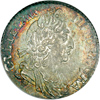 |
Great Britain. Sixpence, 1699. S.3547; ESC-1578; KM-496.10. William III. Third bust. Roses in reverse angles. Lustrous with iridescent toning. NGC graded MS-64.
Estimated Value $800 - 1,000.
The Cheshire Collection.
View details and enlarged photos
| Realized
$776 |
Lot 2264 |
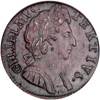 |
Great Britain. Farthing, 1696. S.3557. William III. Hint of obverse luster. NGC graded MS-63 Brown.
Estimated Value $1,100 - 1,300.
The Cheshire Collection.
View details and enlarged photos
| Realized
$834 |
Lot 2265 |
 |
Great Britain. Proof silver Farthing, 1698. William III. P-680. Type as S-3558, the second issue in which the date follows the reverse legend, stop after it. Very scarce. The most curious feature of this specimen is the gigantic "N"s which appear in the legend "BRITANNIA." A lovely example having light gray surfaces, a bit of striking softness as so often is seen in coinage of this era. NGC graded Proof 63.
Estimated Value $1,000 - 1,200.
The Cheshire Collection.
View details and enlarged photos
| Realized
$920 |
Lot 2266 |
 |
Great Britain. Pattern Silver Farthing, 1699. Peck-682. William III. Mottled tone. NGC graded Proof 64.
Estimated Value $1,400 - 1,600.
The Cheshire Collection.
View details and enlarged photos
| Realized
$1,093 |
Lot 2267 |
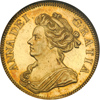 |
Great Britain. Proof gold Guinea, 1702. Queen Anne. Pre-Union First Bust. S-3562, listed without price as "extremely rare." WR-60, listed as R5, just 6 to 10 known in all states of preservation. Plain edge. Design by John Croker. Wilson and Rasmussen's plate coin does not appear to be as sparkling and mark-free as the wonderful specimen we are offering here in this lot. That says volumes, because they generally photograph the best coins they know of, including coins from the British Museum collection. Some of the 6 to 10 known are clearly in museums. The cataloguer has not seen those coins, nor the BM piece, but he did form the Terner Collection and, in some 22 years of eager price-is-no-object searching for the best British gold, never had a chance to buy a Proof 1702 guinea. Such experience supports the accuracy of the old saying that buying a great rarity such as this coin is indeed an opportunity that may only come once in a collecting lifetime. It's not hype. It's reality, truth. However, there are rarities and then there are rarities--great coins that are both ultra-rare and extra-nice. This specimen is what one collecting friend of the cataloguer calls a "cover coin," a coin that is important and handsome enough to occupy the cover of an auction catalogue all by itself. And some cover coin it is! Beautiful and alluring almost beyond words, it sparkles with mirrored-field brilliance, sports a crisp strike, and is made even more lovely by a delicate old-gold reddish toning. As a Proof, it is also struck on a slightly larger or "jumbo" flan compared to that used for a currency coin. Probably the finest known, and without a doubt one of the highlights of the remarkable Cheshire Collection. NGC graded Proof 63.
Estimated Value $17,500 - 22,500.
The Cheshire Collection.
View details and enlarged photos
| Realized
$18,400 |
Lot 2268 |
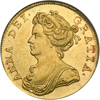 |
Great Britain. 2 Guineas, 1711. S.3569; Fr-319. Anne. Draped bust left. Reverse: Crowned cruciform shields sceptres in angles. Lustrous with considerable mint bloom and exceptionally mark-free surfaces. The queen's portrait is both sensitively drawn and sharply engraved. A forelock drapes over her right shoulder. As nice as any Queen Anne Two Guineas which has been offered for sale in recent years. Rarer than the fivers, but much less expensive. NGC graded MS-62.
Estimated Value $10,000 - 12,500.
The Cheshire Collection.
View details and enlarged photos
| Realized
$9,775 |
|
|